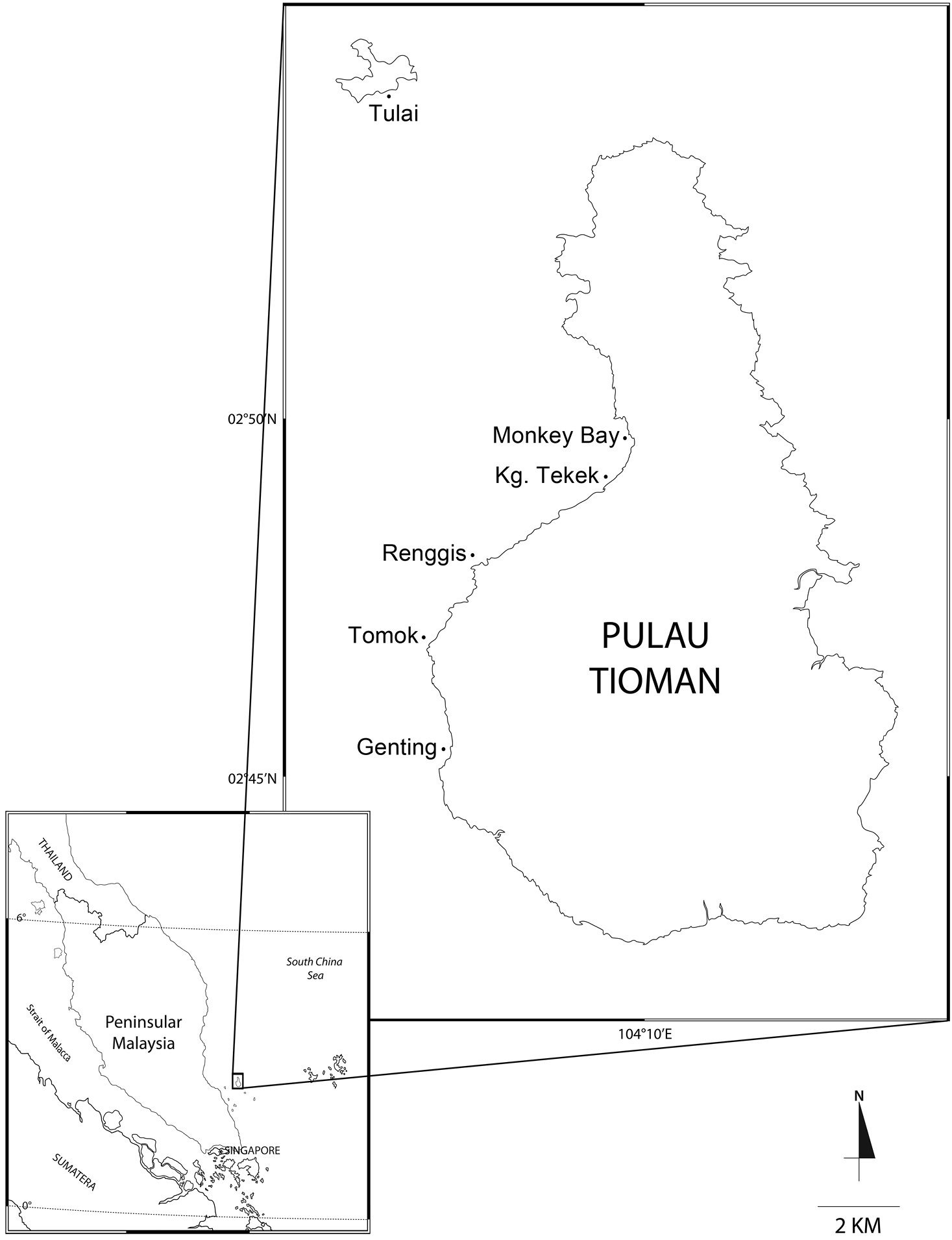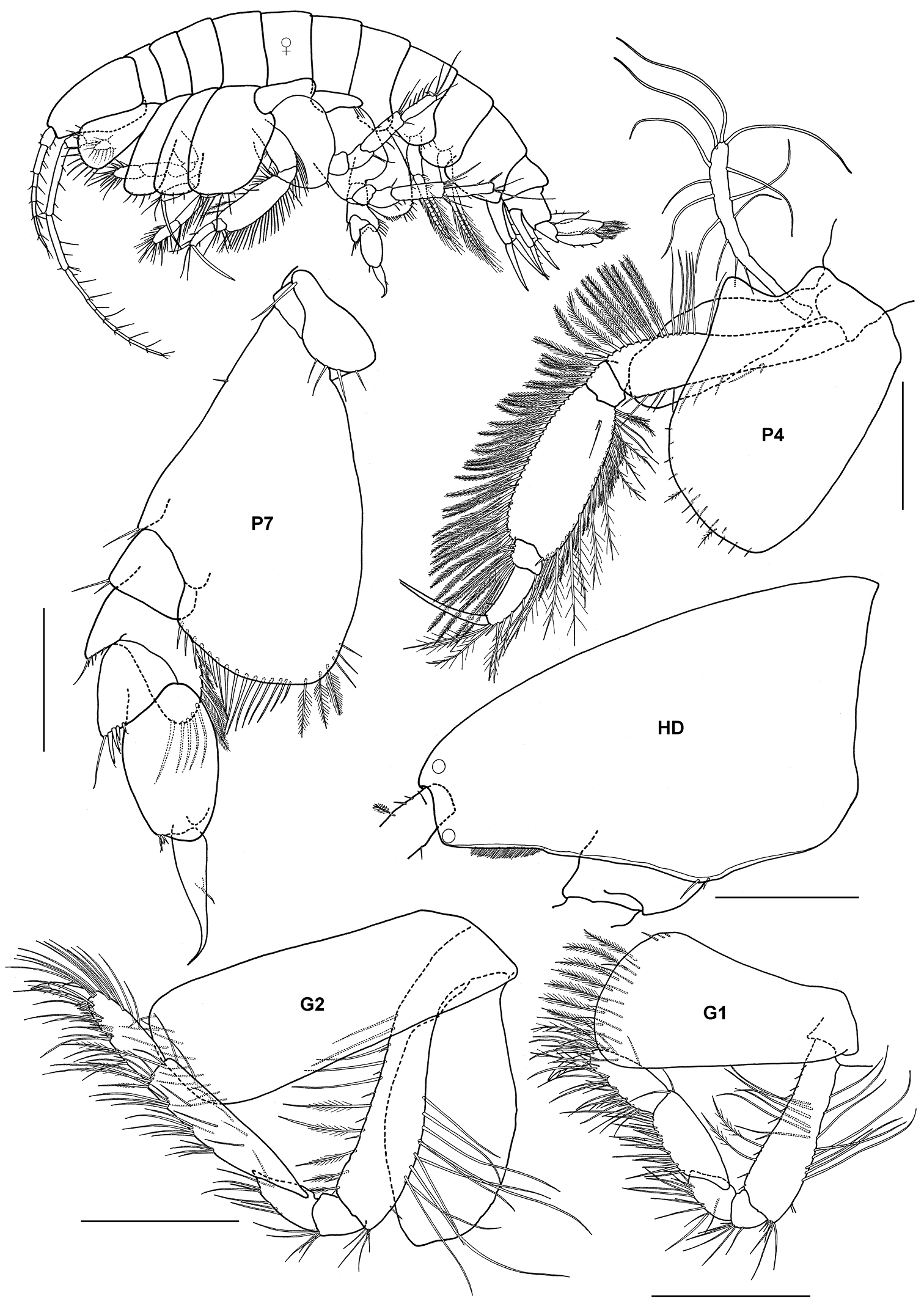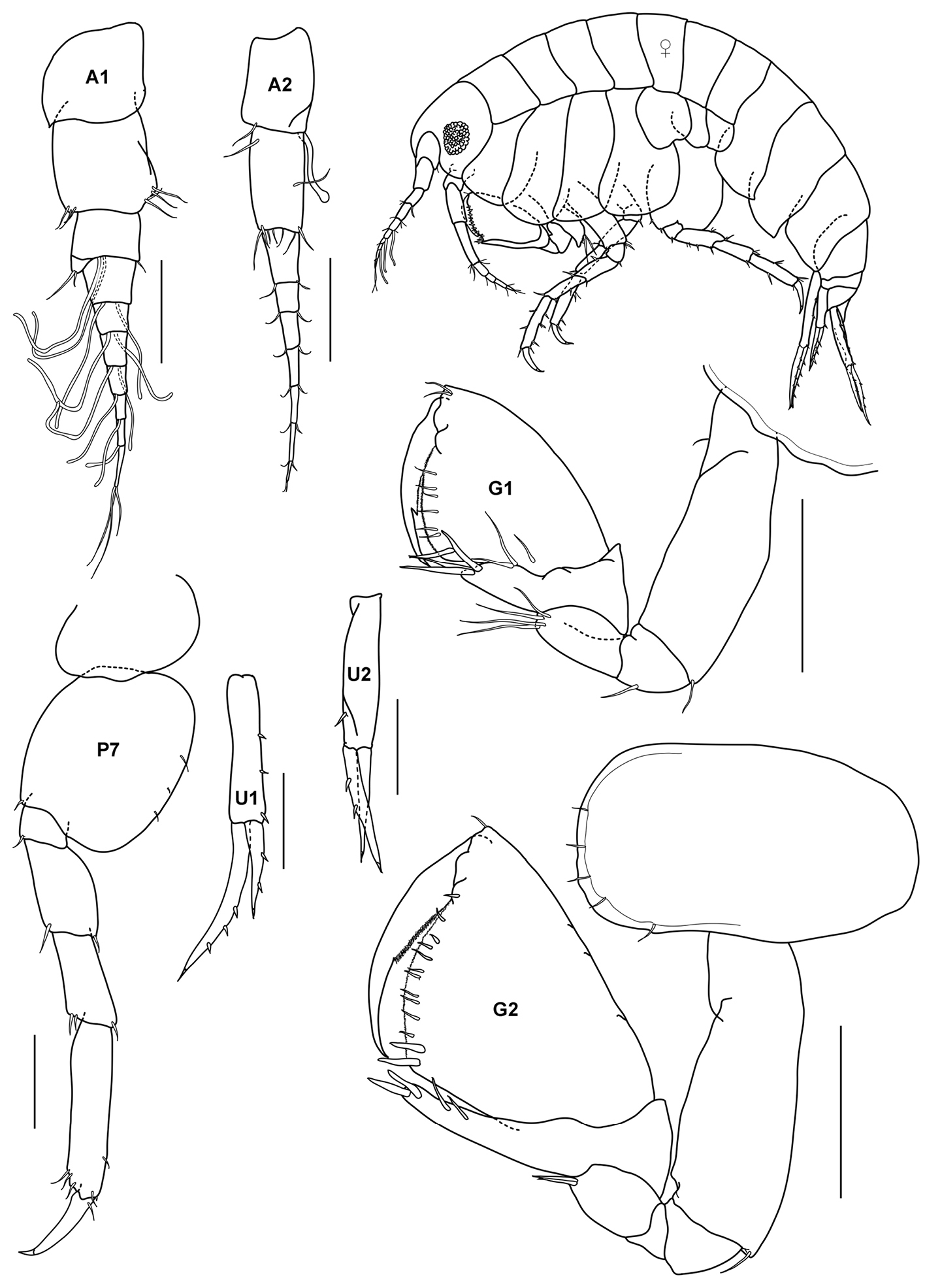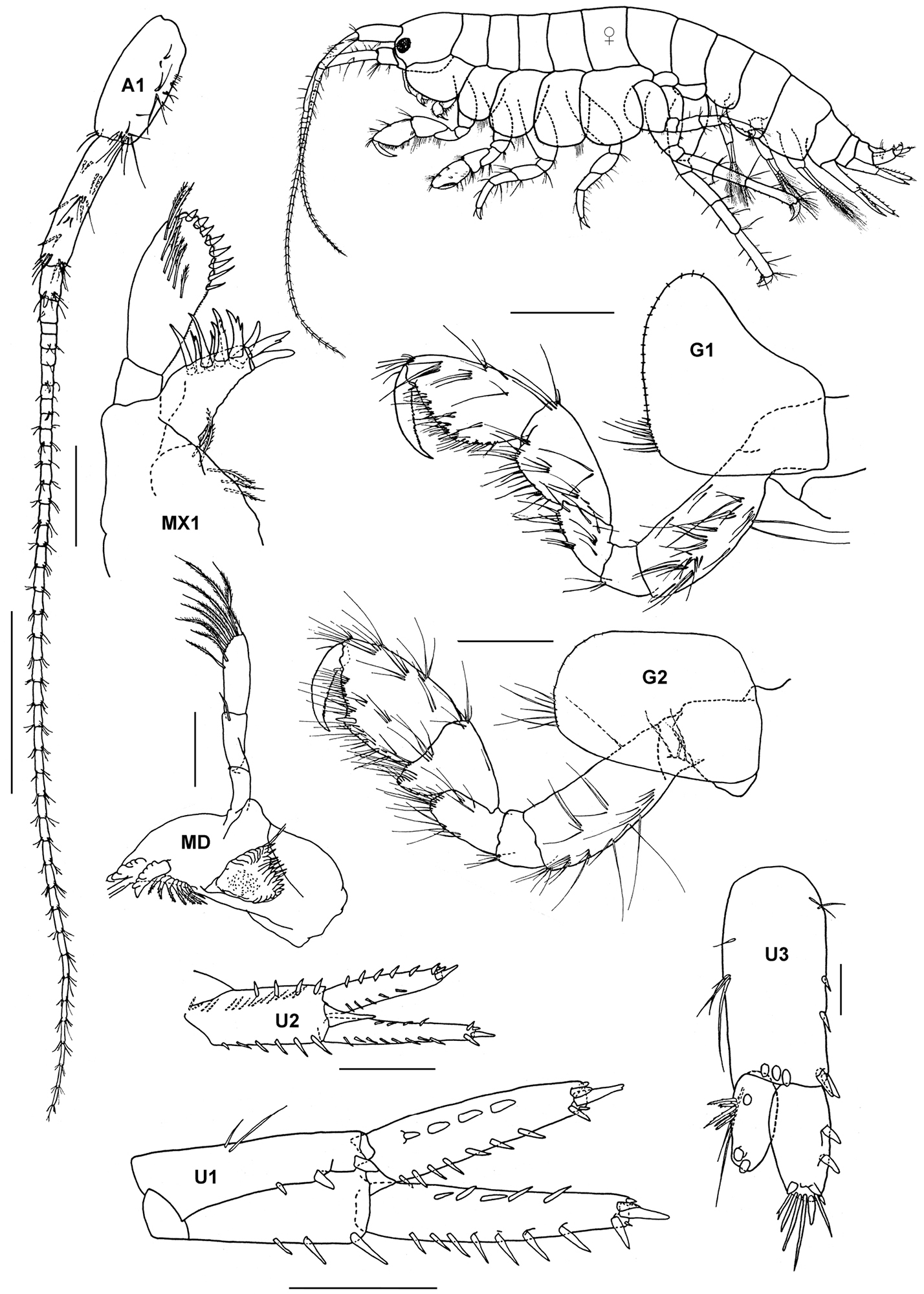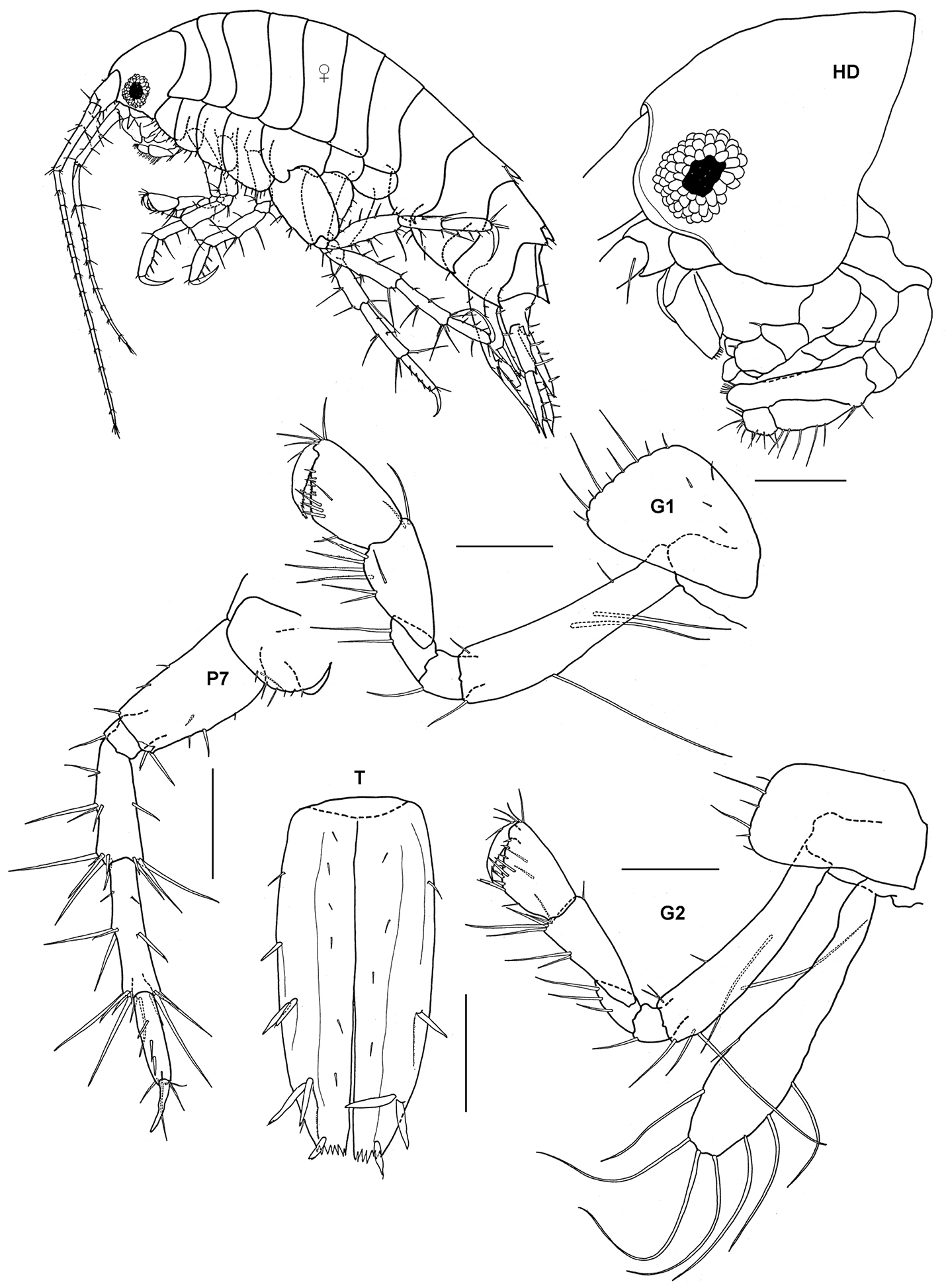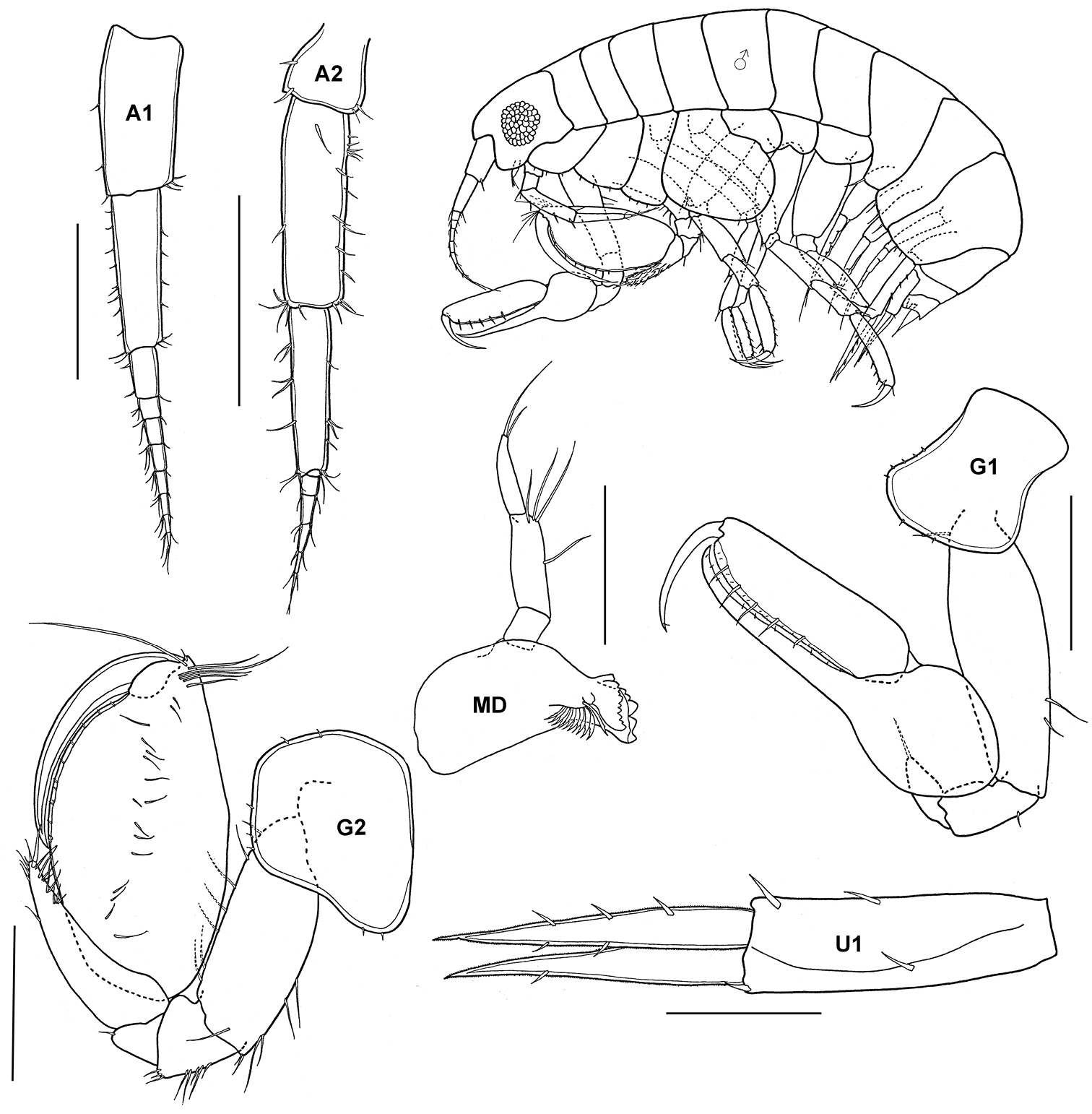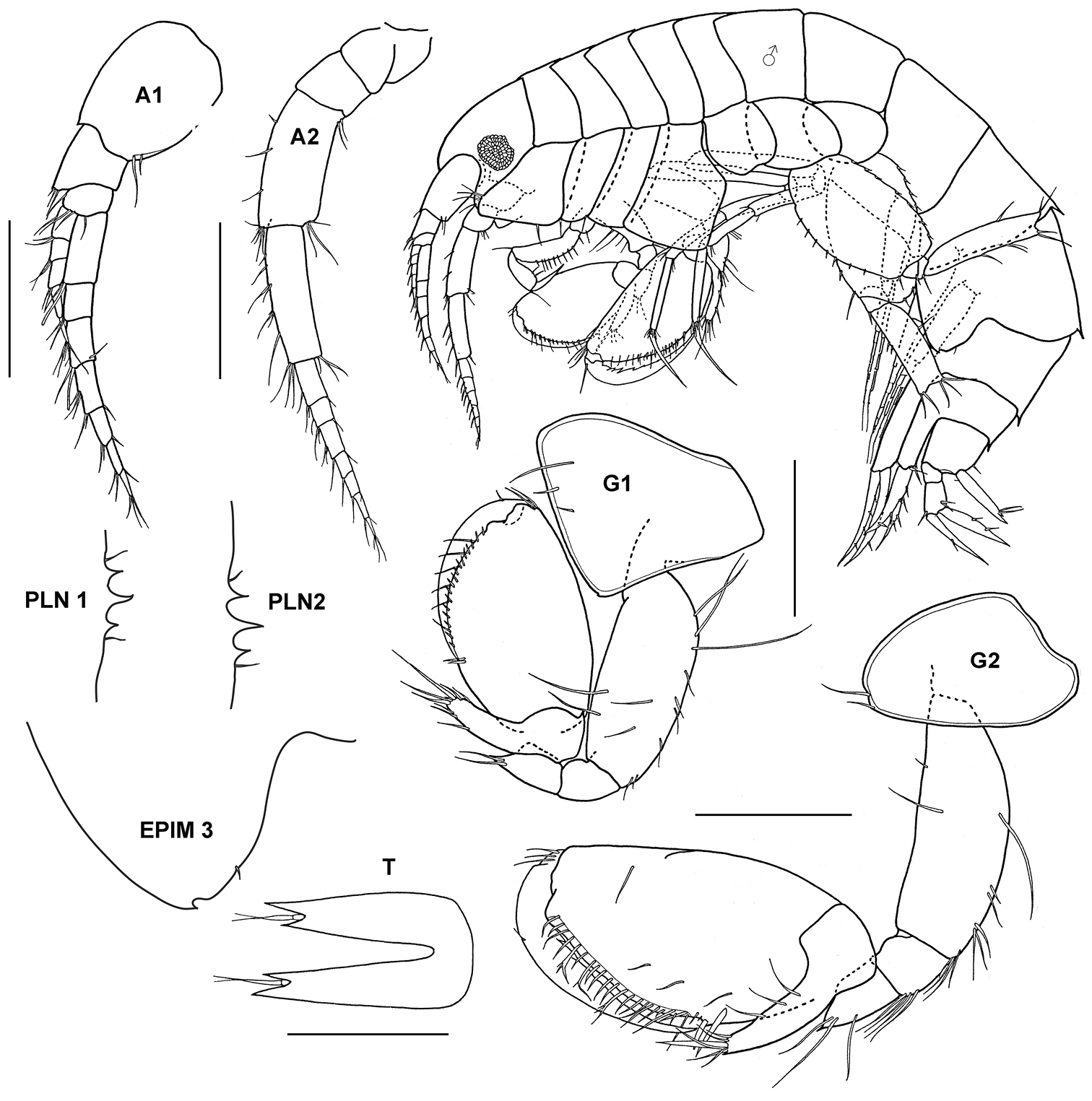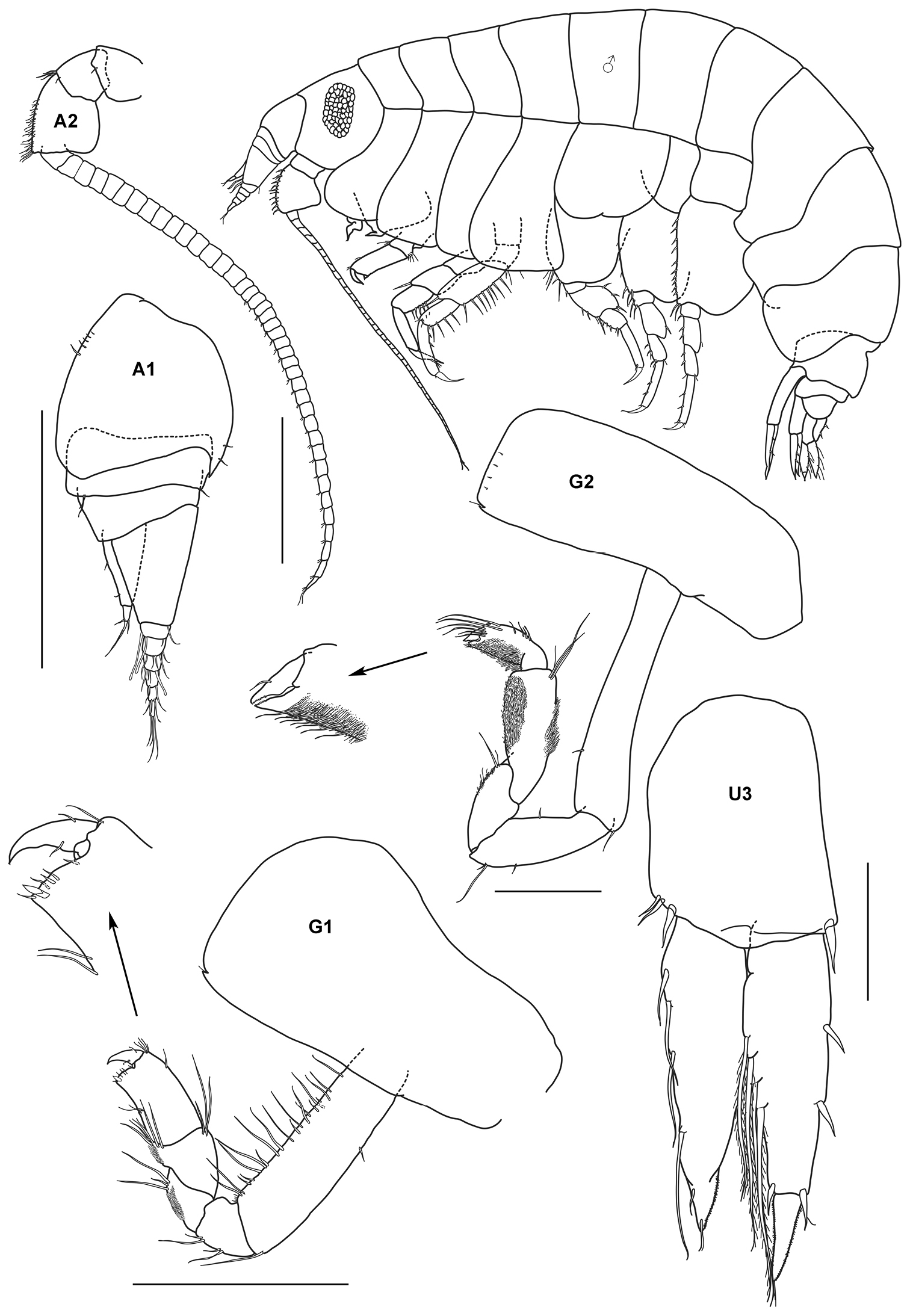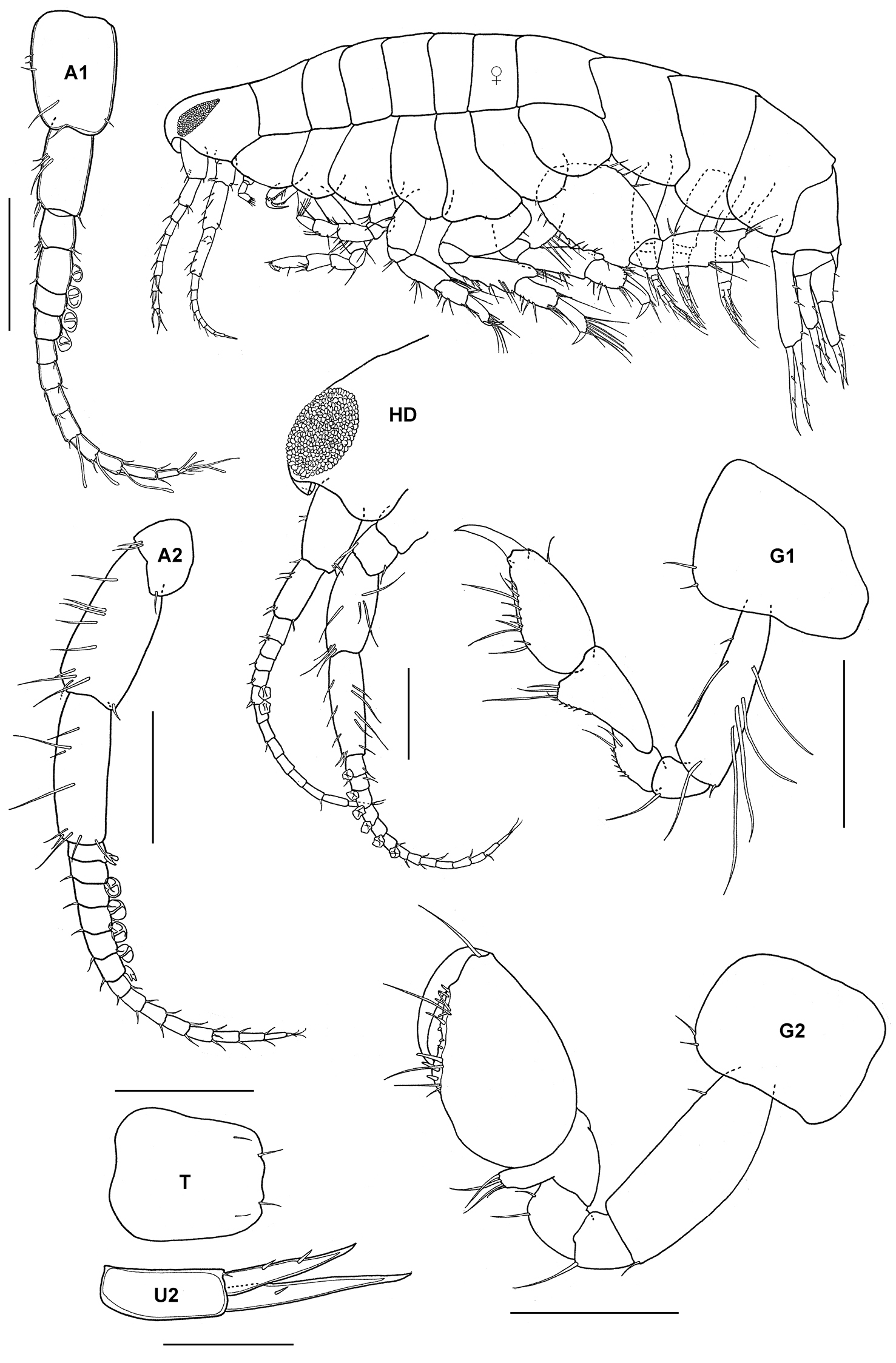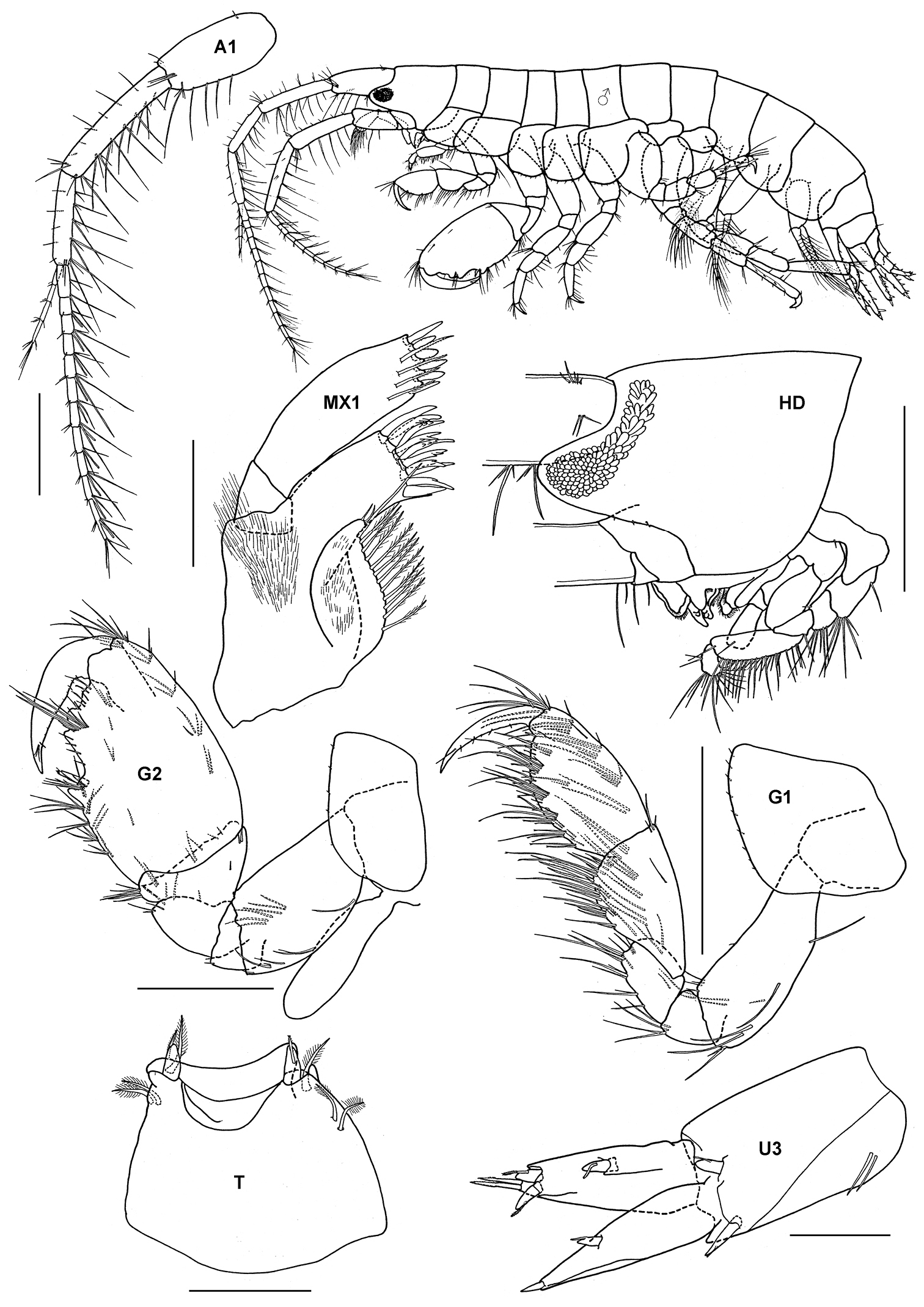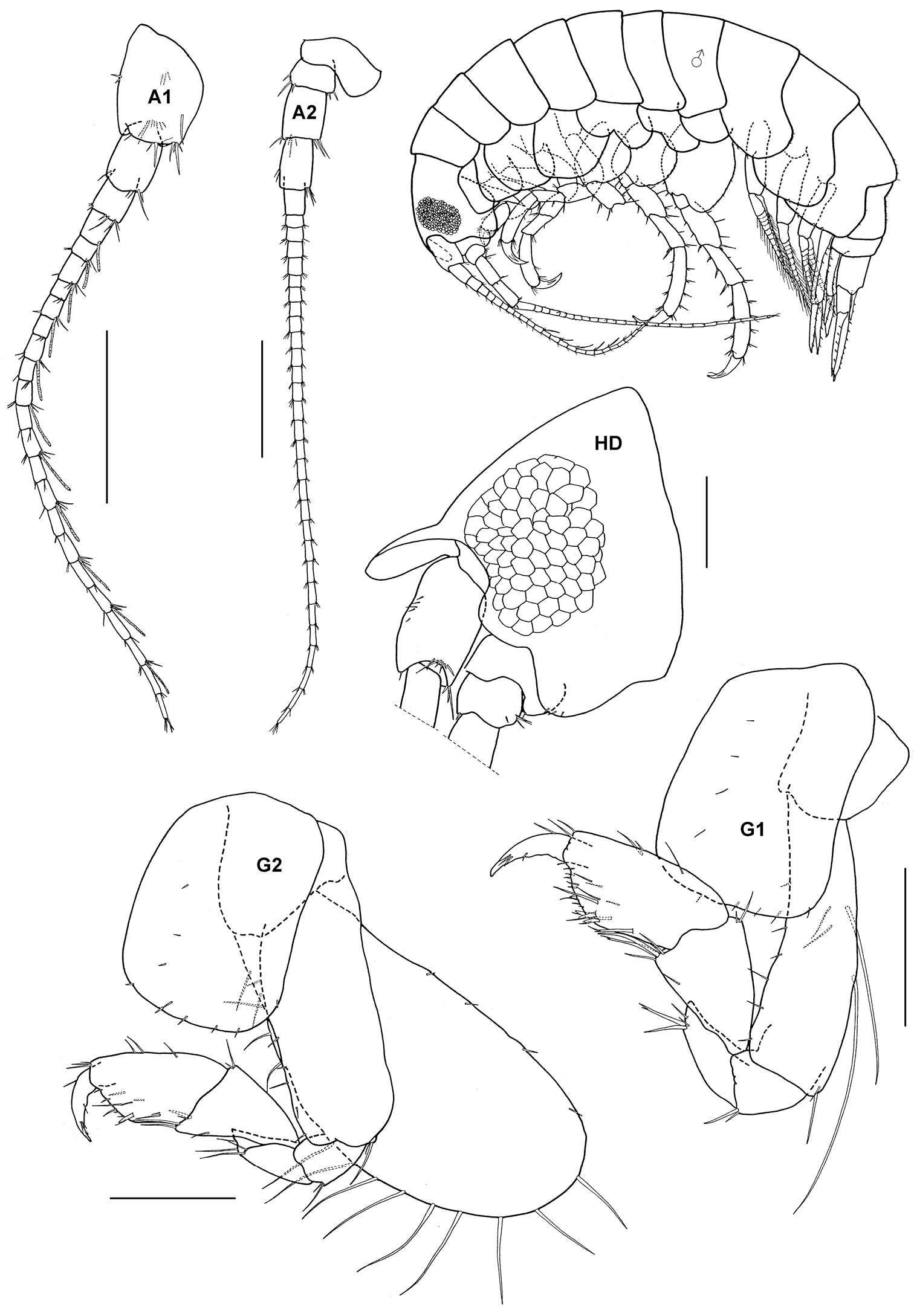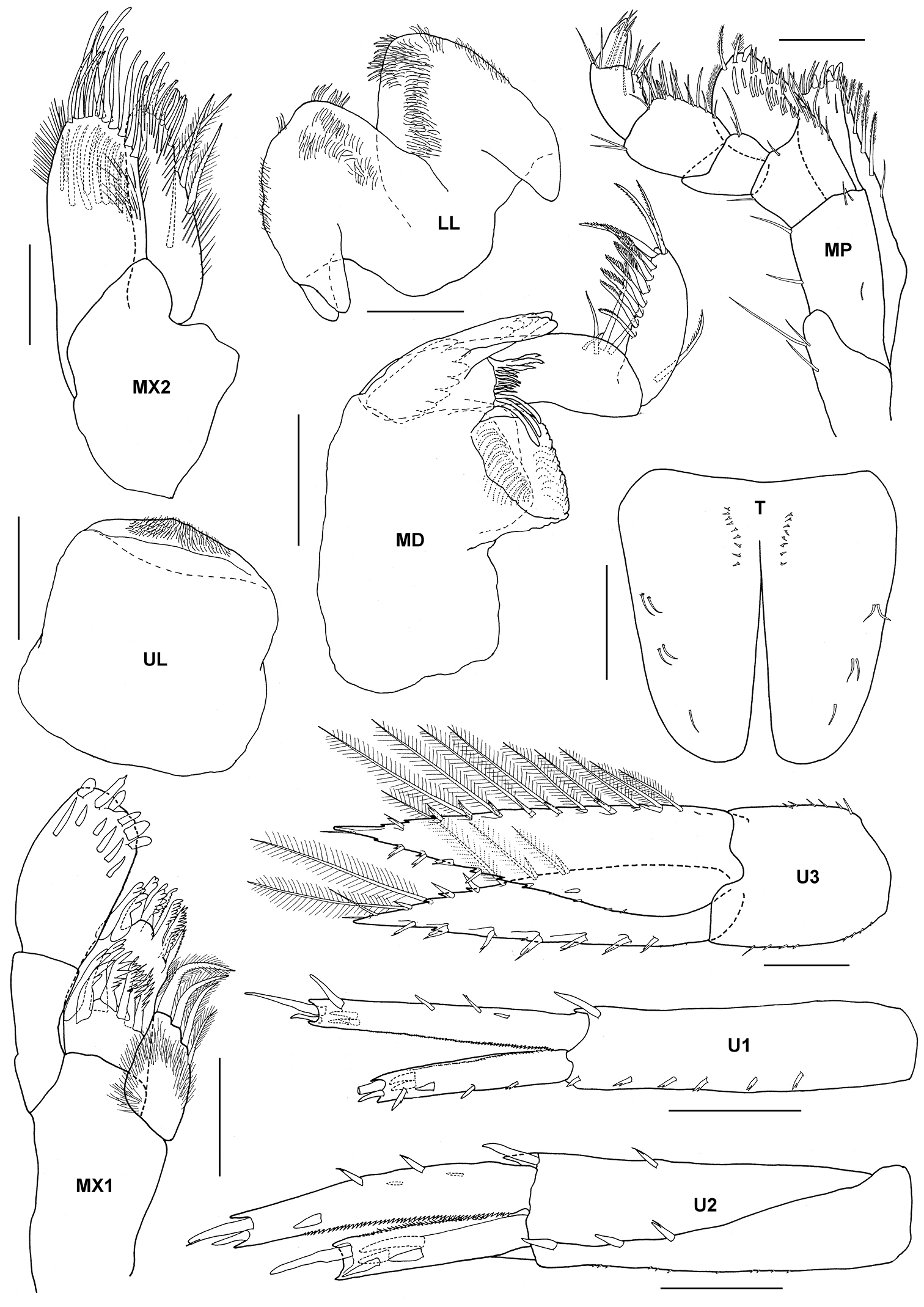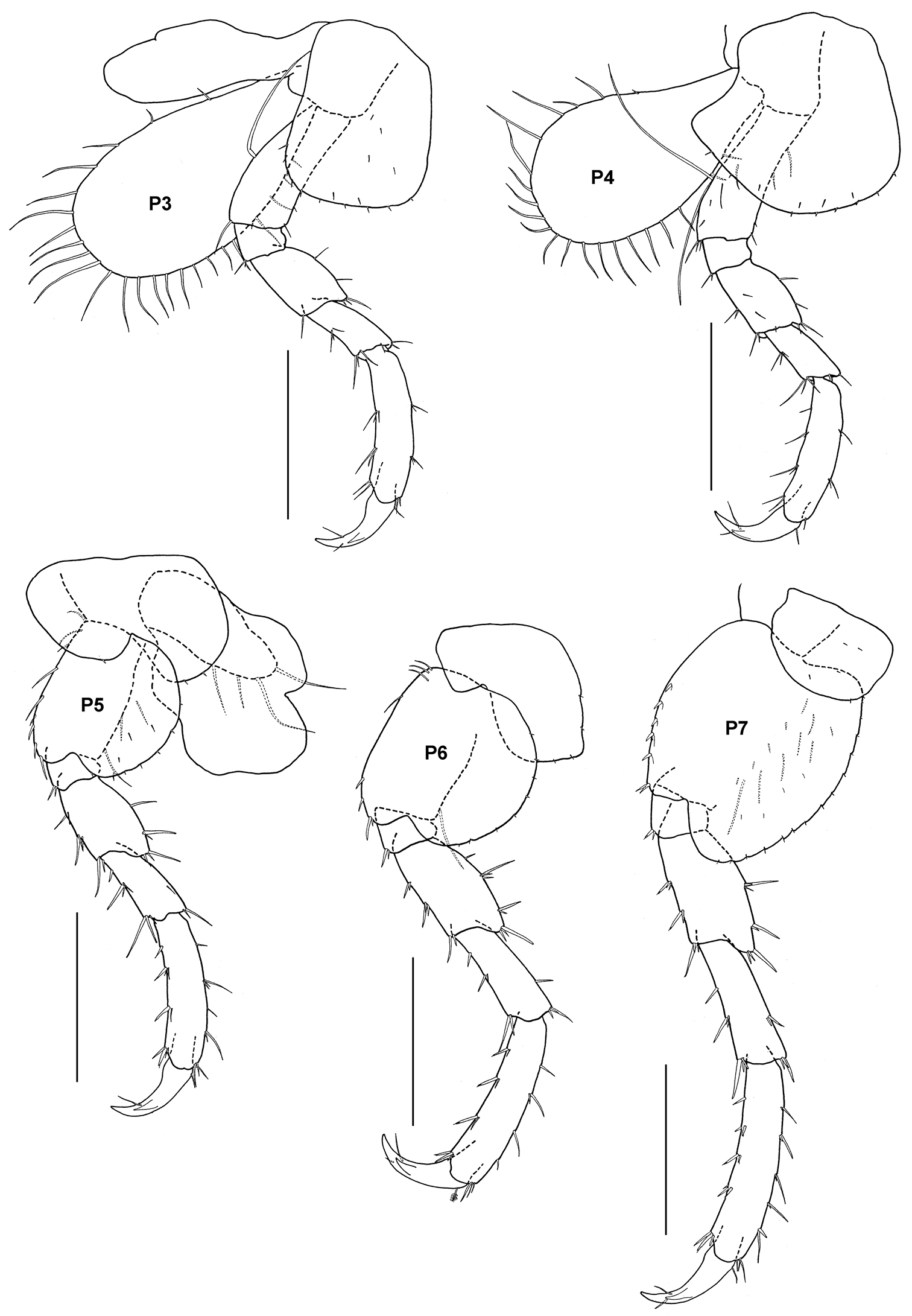






(C) 2013 B.A.R. Azman. This is an open access article distributed under the terms of the Creative Commons Attribution License 3.0 (CC-BY), which permits unrestricted use, distribution, and reproduction in any medium, provided the original author and source are credited.
For reference, use of the paginated PDF or printed version of this article is recommended.
Citation: Azman BAR, Othman BHR (2013) Shallow water marine gammaridean amphipods of Pulau Tioman, Malaysia, with the description of a new species. ZooKeys 335: 1–31. doi: 10.3897/zookeys.335.5567
Eleven taxa including one new species of gammaridean amphipods are reported from the waters of Pulau Tioman. The presence of Tethygeneia sunda sp. n. represents the first record of the genus from the South China Sea. Additional material of Ampelisca brevicornis (Costa, 1853); Cymadusa vadosa Imbach, 1967; Paradexamine setigera Hirayama, 1984; Ericthonius pugnax (Dana, 1853); Leucothoe furina (Savigny, 1816); Microlysias xenokeras (Stebbing, 1918); Monoculodes muwoni Jo, 1990 are identified from the South China Sea, supporting previous records by Lowry (2000), Huang (1994), Imbach (1967), Margulis (1968) and Nagata (1959). Three additional species, Gitanopsis pusilla K.H. Barnard, 1916, Liljeborgia japonica Nagata, 1965b and Latigammaropsis atlantica (Stebbing, 1888), whilst previously reported from the neighbouring waters, comprise new records for the South China Sea.
South China Sea, Amphipoda, Gammaridea, taxonomy, new species, Tethygeneia sunda
According to
Particular efforts in conducting more regional based studies should be emphasized to further advance the biodiversity knowledge of these numerically abundant and taxonomically diverse taxa. Hence, the result of this work should in addition to documenting the amphipod fauna, provide new insights into the diversity and distribution patterns of the South China Sea amphipods.
Located 2°35’ north of the equator and in the South China Sea, Pulau Tioman (pulau = island) is an island of approximately 100 km2 in area, lying 20 km off the southeastern coast of the Malay Peninsular. Apart from its beautiful beaches and marine ecosystems, the marine areas around Pulau Tioman and eight other nearby islands (Pulau Tulai, Pulau Sepoi, Pulau Chebeh, Pulau Tokong Bahara, Pulau Sembilang, Pulau Sri Bulat, Pulau Labas and Pulau Gut) have also been gazzeted as marine parks and marine reserves under the Fisheries Act (1985). The establishment of the marine parks and marine reserves is to conserve, protect marine fauna and flora such as fishes, coral reefs and aquatic floras from being destroyed by fishing and other human activities.
In the framework of research on taxonomic revision and ecology of selected families of gammaridean amphipods conducted at Pulau Tioman, several qualitative benthic samples from different habitats and substrate types have been analysed. In some of these samples, specimens of gammaridean amphipods were found, one of which belongs to new species herein described, and for those species already known, the morphology of populations from Pulau Tioman are compared with other populations described in the literature. Due to the high importance of Pulau Tioman to maintain inventories for scientific marine studies in the Marine Protected Areas of Malaysia, we consider it important to include these species in this report, together with the description of the new taxa.
The material for the present study came from the following locations in the waters of Pulau Tioman, Pahang (2°48'22"N, 104°10'13"E): Kampung Tekek, Renggis, Monkey Bay, Tulai, Tomok and Genting (Fig. 1). Samples of sea grasses, macroalgae, coral rubble, live corals and intertidal rocks were mainly obtained by SCUBA; amphipod specimens were collected by formalin-wash method (Myers 1985).
Study area with localities of sampling stations.
Whole animals were transferred into glycerol and drawn with a camera lucida on an Olympus SZX9 dissecting microscope. The specimens were dissected and appendages and mouthparts mounted onto slides in glycerol and drawn under a Leica DMLB light microscope using a camera lucida. Types have been deposited at Universiti Kebangsaan Malaysia Muzium Zoologi (UKMMZ); and the Australian Museum, Sydney (AM). The following abbreviations are used in the figures. A, antenna; ABD, abdomen; EPIM, epimeron; G, gnathopod; HD, head; L, left; LL, lower lip; LM, lacinia mobilis; MD, mandible; MX, maxilla; MP, maxilliped; P, pereopod; PL, pleopod; PLN, pleonite; R, right; T, telson; U, uropod; UL, upper lip; ♂, male; ♀, female.
http://species-id.net/wiki/Ampelisca_brevicornis
Figure 25 specimens, TIO-15, Renggis, Pulau Tioman, 2°48'35"N, 104°8'6"E, washing mix sea grasses, Azman, B.A.R., Rayida, J., 15 July 1999.
Ampelisca brevicornis is known to be a cosmopolitan species and has been collected from the soft substrata and water column from the littoral zone to the continental shelf from the waters of the world except for boreal areas (
Taking into consideration that Ampelicsa brevicornis is one of the most popular inhabitants on a littoral sea bottom and widely distributed on the sea floor of the east coast (South China Sea) and the west coast (Straits of Malacca) of Peninsular Malaysia, and numerous specimens have been meticulously examined, misidentification can be confidently ruled out. The specimens at hand show only minor disparities from Imbach’s by having a broader propodus of pereopod 7, so it is clearly satisfactory to identify the specimens as Ampelicsa brevicornis.
Ampelisca brevicornis (Costa), female (UKMMZ-1454), 4.8 mm. Renggis, Pulau Tioman. Scales for G1, G2, P4, P7 represent 0.5 mm; HD scale = 0.2 mm.
http://species-id.net/wiki/Gitanopsis_pusilla
Figure 35 specimens, TIO-12, Kampung Tekek, Pulau Tioman, 2 2°49'11"N, 104°9'32"E, macroalgae, Azman, B.A.R., Josim, J.J., 11 November 1997; 5 specimens, TIO-15, Renggis, Pulau Tioman, 2°48'35"N, 104°8'6"E, seagrass, Azman, B.A.R., Rayida, J., 15 July 1999.
The specimens seem referable to the Gitanopsis pusilla without much doubt. In amphilochid amphipods, most species descriptions are based only on females, since the collection of males is rare. The female gnathopods are typical among amphilochids in having a distally dilated propodus, an evenly convex palm and an elongate carpus. The specimens at hand are clearly related to the eastern Pacific species (
Gitanopsis pusilla K.H. Barnard, 1916, female (UKMMZ-1315), 1.7 mm. Kampung Tekek, Pulau Tioman. Scales for A1, A2, G1, G2, P7, U1, U2 represent 0.1 mm.
http://species-id.net/wiki/Cymadusa_vadosa
Figure 43 specimens, TIO 10, Kampung Tekek, Pulau Tioman, 2 2°49'11"N, 104°9'32"E, washing mix macroalgae, Azman, B.A.R., Josim, J.J., 11 November 1997; 4 specimens, TIO 28, Tulai, Pulau Tioman, 2°54'44"N, 104°6'18"E, washing coral rubble, Azman, B.A.R, Kee, A.A., 19 October 2003; 13 specimens, TIO 29, Genting, Pulau Tioman, 2°45'42"N, 104°7'34"E, washing mix macroalgae, Azman, B.A.R., Kee, A.A., 19 October 2003; 5 specimens, TIO 30, Genting, Pulau Tioman, 2°45'42"N, 104°7'34"E, washing mix macroalgae, Azman, B.A.R., Kee, A.A., 20 October 2003.
The well-developed sharp spur on the peduncle of uropod 1 distinguishes the present specimens from the genera Ampithoe Leach, 1814; Macropisthopous K.H. Barnard, 1916; Amphitholina Ruffo, 1953; Psedopleonexes Conlan, 1982; Pseudoamphitoides Ortiz, 1976; Exampithoe K.H. Barnard, 1926 and Melanesius Ledoyer, 1984. Moreover, the expanded propodus of gnathopod 1 with an oblique palm was found to be a sound character in Peramphithoe Conlan & Bousfield, 1982 used in separating Cymadusa from Peramphitoe (Barnard & Karaman, 1991). Cymadusa differs from Amphithoides Kossmann, 1880 by having narrow rami of uropod 3 and the absence of telsonic lobes. Moreover Paragrubia Chevreux, 1901 differ from Cymadusa by having gnathopod 1 larger than gnathopod 2 and in having a multi-articulate accessory flagellum (
The Pulau Tioman specimens also appear to be very close to Cymadusa filosa in having; (1) accessory flagellum with 1 articulate; (2) peduncle of uropod 1 with strong, acute, distoventral interramal process; (3) uropod 2 with short triangular inter-ramal process.
In all probability, this material from Pulau Tioman is very similar to Imbach’s illustrations in having; (1) article 2 of mandibular palp three fourths as long as article 3; (2) maxilliped extends beyond palp article 2; (3) accessory flagellum with 1 articulate; (4) article 5 shorter than article 6 of gnathopod 1; (5) rami of uropod 3 two thirds as long as peduncle; (6) peduncle of uropod 1 with strong, acute, distoventral interramal process; (7) uropod 2 with short triangular interramal process.
Cymadusa vadosa Imbach, 1967, female (UKMMZ-1266), 8.8 mm. Kampung Tekek, Pulau Tioman. Scale for A1, G1, G2 represents 0.5 mm; MX1, MX2 scale = 0.25 mm; U1-U3 scale = 0.2 mm.
http://species-id.net/wiki/Paradexamine_setigera
Figure 524 specimens, TIO 10, Kampung Tekek, Pulau Tioman, 2 2°49'11"N, 104°9'32"E, washing mix species of macroalgae, Azman, B.A.R., Josim, J.J., 11 November 1997, UKM I.D. 4891-4898.
The Malaysian specimens differ from those described from the waters of Japan only by the lack of the accessory setae of the mandible. At present, this seems inadequate for subspecific distinction due to the enormous resemblance of other characters shared between them. Even though
Paradexamine setigera Hirayama, 1984, male, (UKMMZ-1259), 2.1 mm. Kampung Tekek, Pulau Tioman. Scales for G1, G2, HD, T represent 0.1 mm; P7 scale = 0.2 mm.
http://species-id.net/wiki/Ericthonius_pugnax
Figure 62 specimens, TIO 5, Monkey Bay, Pulau Tioman, 2 2°49'33"N, 104°9'45"E, coral rubble, Azman, Josim, 22 August 1996; 86 specimens, TIO 15, Renggis, Pulau Tioman, 2°48'35"N, 104°8'6"E, seagrass, Azman, Rayida, 15 July 1999, UKM I.D. 5712–5719; 2 specimens, TIO 33, Tomok, Pulau Tioman, 2°47'38"N, 104°7'16"E, live corals (Porites sp., Montipora sp., Acropora sp.), Azman, B.A.R, Kee, A.A., Zuhaimi, S., Maekawa, T., Okashita, T., 22 March 2004.
The Pulau Tioman specimens agree well with figures of Ericthonius pugnax from
Ericthonius pugnax (Dana, 1853), male, (UKMMZ-1136), 3.8 mm. Pulau Tioman, South China Sea. Scale for G2 ♂ represents 0.6 mm; A1, A2 HD and ABD scales = 0.5 mm, G1 ♂ scale = 0.25 mm; P5 scale = 0.2 mm.
http://species-id.net/wiki/Leucothoe_furina
Figure 74 specimens, TIO 28, Tulai, Pulau Tioman, 2°54'44"N, 104°6'18"E, coral rubble, Azman, B.A.R, Kee, A.A., 19 October 2003; 1 specimen, TIO 31, Tomok, Pulau Tioman, 2°47'38"N, 104°7'16"E, live corals (Porites sp., Montipora sp., Acropora sp.), Azman, B.A.R., Kee, A.A., Zuhaimi, S., Maekawa, T., Okashita, T., 22 March 2004.
Referred to many times in the literature from Thailand, this is the first record of Leucothoe furina from the intertidal area of the Peninsular Malaysia. The synonymy of this circumtropical species was discussed by
Leucothoe furina (Savigny, 1816), male, (UKMMZ-1459), 3.7 mm, Tulai, Pulau Tioman. Scales for MD and U1 represent 0.25 mm; G1, G2, A1 and A2 scales = 0.5 mm.
http://species-id.net/wiki/Liljeborgia_japonica
Figure 82 specimens, TIO 34, Tomok, Pulau Tioman, 2°47'38"N, 104°7'16"E, live corals (Porites sp., Montipora sp., Acropora sp.), Azman, B.A.R., Kee, A.A., 22 March 2004.
The Pulau Tioman material accords well with the description and figures of
Liljeborgia japonica Nagata, 1965, male, (UKMMZ-1224), 3.2 mm. Tomok, Pulau Tioman. Scales for A1, A2, G1 and G2 represent 0.25 mm; T scale = 0.1 mm.
http://species-id.net/wiki/Microlysias_xenokeras
Figure 93 specimens, TIO 28, Tulai, Pulau Tioman, 2°54'44"N, 104°6'18"E, coral rubble, Azman, B.A.R., Kee, A.A., 19 October 2003.
Microlysias xenokeras Stebbing, male (UKMMZ-1464), 4.2 mm. Tulai, Pulau Tioman. Scales for A1, A2, G1 and G2 represent 0.5 mm; U3 scale = 0.1 mm.
http://species-id.net/wiki/Monoculodes_muwoni
Figure 1010 specimens, TIO 3, Monkey Bay, Pulau Tioman, 2 2°49'33"N, 104°9'45"E, coral rubble, Azman, B.A.R., Josim, J.J., 22 August 1996; 1 specimen, TIO 21, Renggis, Pulau Tioman, 2°48'35"N, 104°8'6"E, seagrass, Azman, B.A.R., Rayida, J., 15 July 1999.
The Pulau Tioman specimens closely resemble
Monoculodes muwoni Jo, 1990, female (UKMMZ-1469), 3.3 mm. Monkey Bay, Pulau Tioman. Scales for A1, A2, HD, G1, G2, U2 and T represent 0.25 mm.
http://species-id.net/wiki/Latigammaropsis_atlantica
Figure 115 specimens, TIO 12, Kampung Tekek, Pulau Tioman, 2 2°49'11"N, 104°9'32"E, macroalgae, Azman, B.A.R., Josim, J.J., 11 November 1997.
Recently
The Pulau Tioman specimens undoubtedly represent the tropical members (afra-atlantica group) by having an article 2 on the outer ramus of uropod 3 and the inner plate of maxilla 1 has at least 3, often 5+ setae lining the medial margin (
Although the Pulau Tioman specimens are more closely related to Latigammaropsis gemina, with the accessory flagellum with 4 articles, inner plate of maxilla 1 with 5+ setae lining the medial margin and occurence of nobs on the urosomal margin. Latigammaropsis gemina still does not agree with the specimens at hand in having oval eyes and the telson lacking medial setae.
Nevertheless the specimens at hand are apparently very close to Latigammaropsis atlantica in having 1) ocular lobes strongly produced with lageniform eye in hyperadults; 2) antenna 2 shorter than antenna 1; 3) male gnathopod 2 with propodus a little longer than carpus; 4) uropod 1 with strong interramal process, two-thirds length of peduncle; 5) uropod 3, peduncle and outer ramus subequal in length with outer ramus stouter than inner with a small second article and 6) telsonic crests with spines and setae. In addition, the Pulau Tioman specimen appears to be referable to the other known Latigammaropsis atlantica that have been recorded from Japan, Bunaken Island, Indonesia, Madras and South Africa.
Latigammaropsis atlantica (Stebbing), male (UKMMZ-1161), 5.1 mm. Kampung Tekek, Pulau Tioman. Scales for A1, G1, G2 and HD represent 0.5 mm; T and U3 scales = 0.1 mm.
http://zoobank.org/51D2394A-BF87-49C5-BB06-8F743D836B8A
http://species-id.net/wiki/Tethygeneia_sunda
Figures 12; 13; 14Holotype, male, body length 4.5 mm (from tip of rostrum to apex of telson) (Ref: UKMMZ-1252).
Marine Park, Pulau Tioman, (2°49'48"N, 104°9'48"E) Peninsular Malaysia; intertidal rocks; coll. Azman, B.A.R., Jusim, J.J., 23 August 2001, UKM I.D. 6687.
32 specimens, TIO 22, Marine Park, Pulau Tioman, 2°49'48"N, 104°9'48"E, intertidal rocks, Azman, B.A.R., Jusim, J.J., 23 August 2001.
Rostrum long and linguiform. Accessory flagellum absent. Maxilla 1, palp article 2 stout armed with several short teeth apically. Maxilla 2, outer plate broader than inner plate, both with plumose setae along margin. Lower lip lacking inner lobes. Mandible palp article 2 long. Gnathopod 2 lacking carpal lobe, more slender articles of carpus and propodus. Pereopods 3-4 with pair of stout locking spines. Telson cleft, lacking large spines on apices.
Male: 4.5 mm. Head, rostrum large, long, curved down, apically blunt, lateral cephalic lobe broad, shallow, quadriform, defined below by weak but sharp incision; antero-ventral margin bulbous, rounded. Eye large, occupying more than half of head area.
Antenna 1 only about 70 percent as long as antenna 2; flagellum with about 21-articulate, ornamented with aesthetascs ventrally; accessory flagellum absent. Antenna 2 about half as long as body; gland cone of peduncular article 2 broad, extending beyond of peduncle article 3; flagellum long and thin with about 28 articles.
Mandible, molar triturative, each with ragged seta; lacinia mobilis serrate and clearly distinct; palp with article 2 about twice as broad as article 3, latter slightly falcate. Lower lip lacking inner lobes, mandibular lobes subtruncate and apically fringed with small setae. Maxilliped inner plate with apicolateral spine separated from 2 medioapical spines by gap and hollow; outer plate with facial setules in 1 row and a few scattered; palp article 2 broad. Maxilla 1, palp article 2 stout armed with several short teeth apically. Maxilla 2, outer plate broader than inner plate, both with plumose setae along margin.
Gnathopod 1-2 small, subequal in size to each other, basis scarcely setose posteroventrally; propodus long, thin, sub-rectangular, palm evenly oblique.
Gnathopod 1 carpus sub-triangular, posterior margin short, lobe extended; dactylus not serrate on grasping margin. Gnathopod 2 similar to gnathopod 1. Pereopods 1-7 elongate. Pereopods 3-4 homopodous; merus slightly expanded posterodistally; carpus about ½ the length of propodus. Pereopods 5-7 homopodous; basis expanded roundly. Pereopod 7 similar but longer than pereopod 6; basis more elongate than pereopod 6.
Uropod 1 peduncle spinose on lateral margin, almost 2 times as long as outer ramus, one medium sized robust seta at distal part; outer ramus about 0.7 times as long as inner ramus, apex bifid, armed with several apical spines, one elongate. Uropod 2 extending beyond telson; peduncle subequal in length to inner ramus, spinose, and with one long robust seta at distal end; outer ramus almost 0.6 times as long as inner ramus with several apical robust setae; inner ramus apically bifid with several robust setae along margin. Uropod 3 peduncle short; rami foliaceous, subequal in length, marginally spinose and setose. Telsonflat, broad, cleft more than halfway, apices slightly rounded, broad, smooth, lateral margins of lobes with 2 pairs of partial sets of fine short setae.
The specific designation is derived from the name of the Sunda shelf, which was part of the south-east Asian continent during the Pleistocene.
Tethygeneia sunda sp. n., holotype, male (UKMMZ-1252), 4.5 mm. Marine Park, Pulau Tioman. Scales for A1 and A2 represent 0.5 mm; G1, G2 and HD scales = 0.25 mm.
Tethygeneia sunda sp. n., holotype, male (UKMMZ-1252), 4.5 mm. Marine Park, Pulau Tioman. Scales for MX1, MX2, UL, LL, MP, MD, U1–U3 and T represent 0.1 mm.
Tethygeneia sunda sp. n., holotype, male (UKMMZ-1252), 4.5 mm. Marine Park, Pulau Tioman. Scales for P3–P7 represent 0.5 mm.
Checklist of the recorded amphipods.
| Family/Subfamily | Genus | Species |
|---|---|---|
| Ampeliscidae Costa, 1857 | Ampelisca Kröyer, 1842 | 1. Ampelicsa brevicornis (Costa, 1853) |
| Amphilochidae Boeck, 1871 | Gitanopsis Sars, 1895 | 2. Gitanopsis pusilla Barnard, 1916 |
| Ampithoidae Stebbing, 1899 | Cymadusa Savigny, 1816 | 3. Cymadusa vadosa Imbach, 1967 |
| Dexaminidae Leach, 1814 | Paradexamine Stebbing, 1899 | 4. Paradexamine setigera Hirayama, 1984 |
| Ischyroceridae Stebbing, 1899 | Ericthonius Milne-Edwards, 1830 | 5. Ericthonius pugnax (Dana, 1853) |
| Leucothoidae Dana, 1852 | Leucothoe Leach, 1814 | 6. Leucothoe furina (Savigny, 1816) |
| Liljeborgiidae Stebbing, 1899 | Liljeborgia Bate, 1862 | 7. Liljeborgia japonica Nagata, 1965a |
| Lysianassidae Dana, 1849 | ||
| Tryphosinae Lowry & Stoddart, 1997 | Microlysias Stebbing, 1918 | 8. Microlysias xenokeras (Stebbing, 1918) |
| Oedicerotidae Liljeborg, 1865 | Monoculodes Stimpson, 1853 | 9. Monoculodes muwoni Jo, 1990 |
| Photidae Boeck, 1871 | Latigammaropsis Myers, 2009 | 10. Latigammaropsis atlantica (Stebbing, 1888) |
| Pontogeneiidae Stebbing, 1906 | Tethygeneia J.L. Barnard, 1972 | 11. Tethygeneia sunda sp. n. |
We are grateful to Zuhaimi Samat, Shamsul Bahar, Jenifer Jusi Josim, Kee Alfian, Rayida Jaraeh, Tomoko Okashita and Takeshi Maekawa who assisted in the field sampling. This work was supported by a grant (UKM-ST-08-FRGS0020-2009) from the Ministry of Higher Education of Malaysia and a UKM research grant (DIP-2012-020). Thanks are also due to the Marine Park Section, Department of Fisheries, Malaysia.
